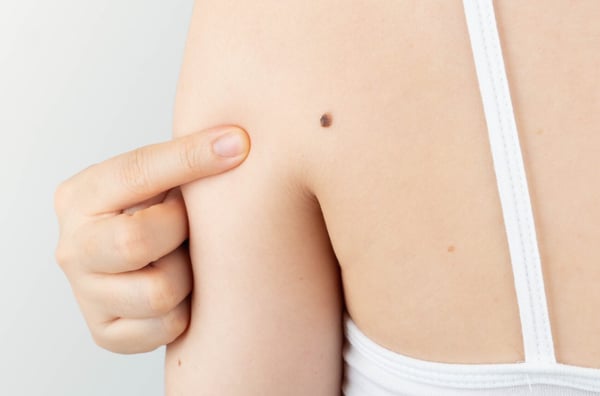
Wait, that’s new… It looks like a pimple, maybe a mole? It’s definitely some kind of bump. That wasn’t there before. Does that mean it’s cancer?
This is one of the most common questions: You notice a new blemish or bump, and the worry sets in. You want to be proactive, but you can’t run to the doctor’s office every time you see something new on your skin.
Your questions are valid. After all, skin cancer is the most common form of cancer in the United States, and about one in every five Americans will develop some type of skin cancer in their lifetime. And while the two most common forms – basal cell carcinoma and squamous cell carcinoma – are highly treatable, the overall incidence of both has been increasing in recent decades. Then there’s the dangerous melanoma: While the American Cancer Society reports melanoma only makes up about 1% of all skin cancers in the U.S., it’s also the deadliest.
So, what’s the best way to protect yourself? Learn what to look for when you notice something new on your skin so you’ll know when to visit a dermatologist and when you can simply get on with your day.
What are the four telltale signs of cancer?
Skin cancer can show up in a variety of ways, which is why recognizing the important signs early is crucial for effective treatment. Watch for anything that resembles these common indicators:
1. Changes in moles or other spots
Use the ABCDE tool to spot any potential cancer-related growth:
- Asymmetry-an uneven shape
- Border – irregular, notched or scalloped edge
- Color – multiple shades within the mole
- Diameter -anything larger than a pencil eraser
- Evolving appearance -any changes in size or shape, or a change in symptoms like itching
2. Unusual growths
Look for hard lesions or any spots that crust, ooze, or bleed. The American Cancer Society also provides sample photos of growths to watch for.
3. Persistent skin changes
Watch for sores or bumps that don’t seem to heal, as well as those with red, scaly patches, rough skin, or wart-like lumps.
4. Signs of rare cancer types
Keep a close eye on your palms, soles, and under your nails for any new growths or skin conditions, as these may be signs of acral melanoma, a rare cancer type.
Are there conditions that can be mistaken for skin cancer?
To make matters more complicated, several harmless skin conditions can sometimes resemble cancerous growths, making it tough to tell the difference without a consultation with a dermatologist:
- Psoriasis – This chronic skin condition can cause red and scaly patches that are often mistaken for cancer.
- Seborrheic keratoses – These benign skin tumors can sometimes resemble melanoma due to their scaly brown appearance.
- Sebaceous hyperplasia – Some individuals have enlarged oil glands that create small, yellow bumps in the hair follicles that can look like basal cell carcinoma.
- Moles – Some common moles can nevertheless have irregular borders and various colors, which is one warning sign for melanoma.
- Cherry angiomas – Bright red in color, these benign growths often show up on people over 40 and can easily be mistaken for cancer.
Does skin cancer itch?
While itching is never a definitive symptom of cancer, skin cancer can indeed cause itching. The symptom can be due to the inflammation caused by the cancer’s impact on the nerve endings in your skin.
In cases of melanoma, you may experience itching as the mole or lesion changes in texture, size, or shape. With the other two more common skin cancer types, you may experience itchy (and painful) lesions that can also bleed, or pink bumps that ooze or crust and cause itchiness.
How long can you have skin cancer without knowing?
Basal cell carcinoma – with its hallmark painless bump or flat scar-like lesion – may be the most common type of skin cancer, but it’s also the slowest-growing, often going unnoticed for years. Squamous cell carcinoma may appear as a red, scaly patch or a small nodule that’s firm to the touch, which can also take months or even years to be noticed.
Melanoma – typically aggressive and can grow and spread quickly. Yet, in its early stages, melanoma can look like an ordinary mole and hide in plain sight for months or years. This is especially true for melanoma in areas that are harder to detect, such as on the scalp or under the nails.
You could have skin cancer and not know it, which is another good reason to have regular skin checks with your dermatologist, who can spot skin cancer at an early stage when it’s most treatable.
When in doubt, consult a professional
If you’re worried about a new bump, mole, or lesion that has any of the four main indicators of cancer, don’t delay, make an appointment at the nearest Forefront Dermatology office today. One of our board-certified dermatologists can answer all your questions and help you gain the peace of mind you’re looking for.





